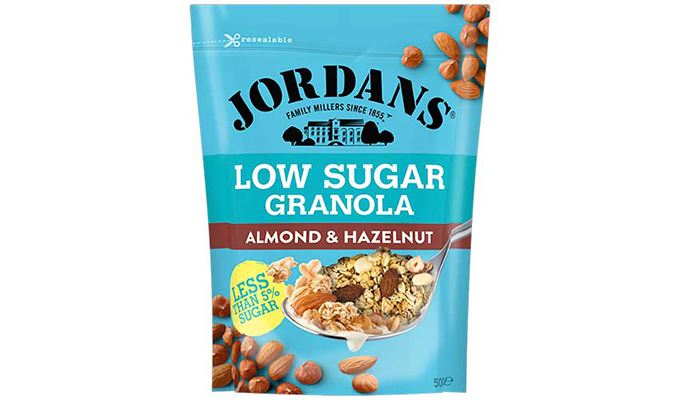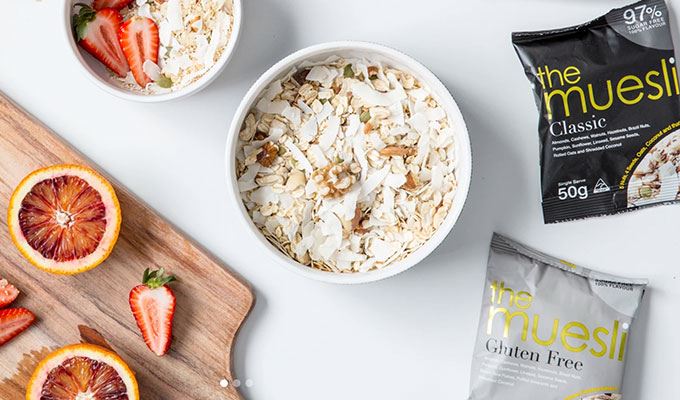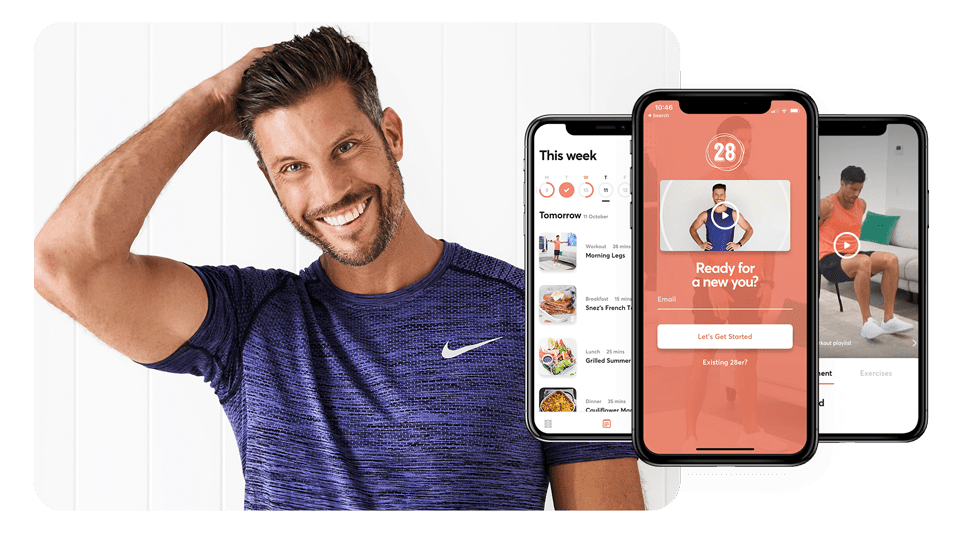As a qualified nutritionist, I’m often asked for advice on quick and easy breakfast options, and everyone wants to know what the healthiest cereals are. My first answer is probably not the one you want to hear: homemade cereals are the best and healthiest option. But the next-best option is to find the healthiest cereal you can at your local supermarket.
The challenge is knowing what a healthy cereal looks like, and how to quickly navigate past all the confusing marketing jargon when you’re in the cereal aisle at the supermarket. The good news is that, by the end of this article, you’ll be a pro at finding and buying healthy cereals… just keep on reading!
Why it’s hard to find a healthy cereal in the supermarket aisles
Unfortunately, the food industry has gotten really good at marketing unhealthy cereals as healthy, and they know how to do this without breaking any Australian food labelling laws. That’s why you shouldn’t believe what the cereals say about themselves on the packaging, but you CAN believe what their nutritional panels say – simply because it’s required by law to be accurate.
It’s only when you know how to read the nutritional panels that the real story of what is (and isn’t) healthy becomes clear.
I’m going to show you how to see past all the food marketing jargon so you can buy a quality cereal that will help you start your day right. But, if you’re short on time today, feel free to jump straight to my healthiest cereal review, so you can make healthier breakfast choices for you and your family straight away.
What makes a cereal ‘healthy’?
Contents
Healthy is a very general term, and it means something slightly different to everyone; however, as a qualified nutritionist, I have a very clear definition of what a healthy cereal looks like (and why) which I’ll explain in a moment.
These are the 4 main factors I consider when assessing how healthy a store-bought cereal is:
- The type and quality of ingredients used
- The amount of sugar per 100g
- The fibre content per 100g
- The number of calories in a standard serving
You’ll notice the calories of a standard serving of cereal isn’t in my top 3. This is because, when it comes to your overall health, the quality of the calories you eat is more important than the number of calories you consume.
Most-bought cereals fall into the unhealthy category because they’re heavily processed or full of added sugar and additives, and this means they simply aren’t what I would consider a quality fuel for your body. There are healthier breakfast cereal options you can eat, that are just as quick to buy and eat, that will power you through your day a lot better.

If a cereal doesn’t pass our top 3 criteria for quality ingredients, low sugar and high fibre, buy something else.
The good news is that there are healthy cereals on Australian supermarket shelves… you just need to know what to look for.
If you’d rather skip the details and you want a fast guide, here it is: buy a muesli!
🙂
Muesli is generally the easiest and healthiest cereal you can buy. Of course, not all mueslis are created equal, as you’ll soon learn.
What do we mean when we call something a ‘high quality’ cereal ingredient?
Our nutrition team here at 28 classify a quality ingredient to mean any food used in its natural form, without manipulation.
Does your cereal contain healthy, quality ingredients?
The first step to choosing a quality cereal is to know what is (and isn’t) a quality ingredient.
If you want to buy a healthy cereal with quality ingredients, just take a look at the ingredient list. If you see a number or a word that looks like a science experiment, chances are it isn’t a natural food and, therefore, it isn’t a quality ingredient so it doesn’t belong in our cereal.
Quality ingredients you might see in a healthy cereal include:
- Whole grains: like rolled oats, barley, spelt, quinoa, puffed rice, etc.
- Nuts: including almonds, walnuts, brazil nuts, hazelnuts, macadamias, etc.
- Seeds: such as sunflower seeds, pumpkin seeds, chia seeds, linseed, etc.
It’s a good sign if the ingredients on the side of your breakfast cereal box mentions ‘whole grains’, ‘nuts’ or ‘seeds’ but, be warned, this doesn’t mean your cereal is definitely healthy. There could be other factors holding it back, which I’ll explain next.
Keep on reading to learn how to find healthy cereals. Plus we explain our problem with vegetable oil and how you can spot hidden sugars in cereal!
What are the healthiest cereals in Australian Supermarkets?

WINNER HEALTHIEST CEREAL IN AUSTRALIAN STORES (2021)
Carman’s Muesli Original, Fruit Free
Ingredients: Whole Grain Oats, Nuts (Almonds 9%), Pecans 1%), Golden Syrup, Seeds (Sunflower Seeds, Pepitas 3%, Sesame Seeds), Sunflower Oil, Oat Flour, Cinnamon.
- Serving size: 45g
- Sugar per 100g: 8g
- Fibre per 100g: 9.6g
- Calories per 100g: 451 kcal
THE NUTRITIONIST’S VIEW: Overall, most of the ingredients are good and meet our quality ingredient criteria, however golden syrup and sunflower oil are ingredients we don’t recommend as something you consume regularly. With just 8% sugar, it just passes the sugar test and also has a decent fibre content. In terms of calories, it’s 203 kcal per serve, which is the perfect amount to then serve with natural Greek yoghurt and fresh berries of your choice.
The truth is, the healthiest cereals aren’t sitting in the supermarket, they are the ones you make at home. But, let’s be realistic, most of us don’t have time to make every meal from scratch. So if you have run out of time, but still want to be healthy, choose any cereal that meets (or comes close to meeting) our recommended criteria of a healthy cereal.
RUNNER-UP FOR HEALTHIEST SUPERMARKET CEREAL (2021)
Jordans Granola Low Sugar Almond Hazelnut 500g
This store-bought cereal from Jordans came in as a very close second for the healthiest cereal award.
Ingredients: Whole Grain Oat Flakes (55%), Barley Flakes (19%), Chicory Root Fibre (11%), Nuts (7%) (Sliced & Whole Almonds (5%), Chopped Roasted Hazelnuts (2%)), Sunflower Oil, Seeds (1%) (Pumpkin Seeds, Sunflower Seeds), Desiccated Coconut, Natural Flavouring.
- Serving size: 45g
- Sugar per 100g: 2.9g
- Fibre per 100g: 7.9
- Calories per 100g: 448 kcal
THE NUTRITIONIST’S VIEW: Overall this cereal from Jordan’s is better than many of the other cereals on Australian supermarket shelves. It has very low sugar levels and the fibre content is close to ideal – however – it does contain sunflower oil which we’d prefer you limit or avoid. And it also uses ‘natural flavours’ which is a misleading term that we should all be wary of.

Muesli is always perceived as the healthiest cereal option, and it usually is, but you still need to be vigilant and look at nutritional label to be 100% sure.
How to spot hidden sugars in your cereal
One way to keep it simple is to keep an eye out for sugar by name or by sugar content – and then just avoid that cereal altogether. The biggest challenge to this approach is usually recognizing sugar for what it is.
There are two main ways to find hidden sugars in your food
- You can check the overall sugar levels on the nutritional panel
- You can check the ingredients to see if sugar is high on the list – if you can recognize the name!
How to read the ingredients list on your box of cereal
Food labels always show the ingredients used in your cereal in an ordered list, from the highest percentage to the lowest.
Sugar can be sneaky, as it can hide in your ingredients list under many different names.
For example, the following ingredients are all commonly found in cereals, and they are ALL sugar:
- Glucose
- Sucrose
- Dextrose
- Golden syrup
- Glucose syrup
- Honey
- Maple syrup
- Rice malt syrup
- Date syrup
- High-fructose corn syrup
- Brown sugar
- Raw sugar
- Agave syrup
- Coconut nectar syrup
- Maltodextrin
- … And the list goes on!

Sugar can be sneaky!
It can hide in your cereal ingredients under different names, so learn the names it likes to hide behind!
Can you find the sugars on this ingredients list?
Take a look at the following ingredient list, taken from the side of a Kellogg’s Sustain cereal box. Not only is there ‘sugar’ in the list below, but there are also things called ‘invert syrup’ and ‘barley malt extract’, both of which are…. sugar!
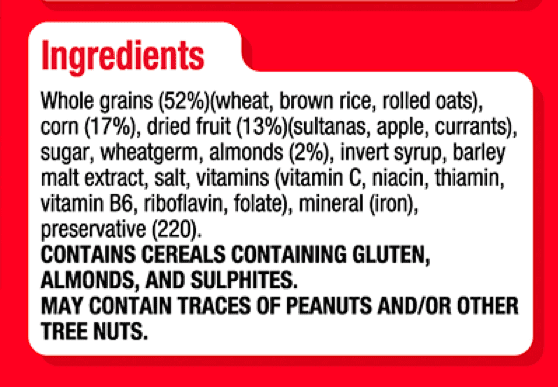
How to read the nutrition panel to know if sugar is hiding in your cereal
- Look at the cereal’s nutrition panel
- Directly underneath ‘carbohydrates’, you’ll find ‘sugars’.
- Look across at the amount of sugar per 100g
- The number you’ll see tells you what percentage of the cereal is pure sugar.
Let’s try a little test.
Take a look at the nutritional panel below from Kellogg’s Sustain. What is the sugar content of this cereal? Try to find it yourself, and I’ll give you the answer below.
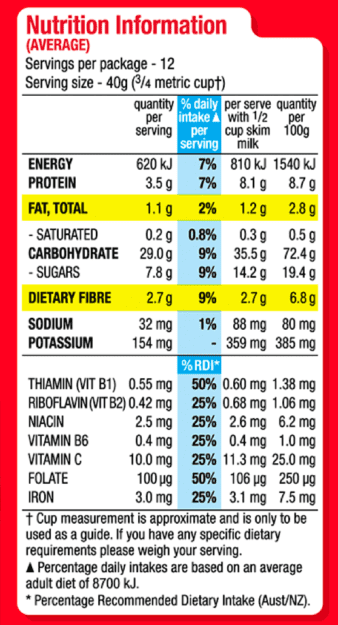
How much sugar is in Kellogg’s Sustain?
19.4g per 100g.
This means you’re eating nearly 20% sugar in every bowl of Sustain cereal – and that’s before we count the natural sugars contained in the milk you’ll pour over it!
The quality of the calories you eat is more important than the quantity of calories you consume. That’s why you’ll find the “healthiest cereals” are not always the ones with the lowest calories or the lowest sugar content.
How many calories should a healthy cereal have?
We don’t advocate counting calories as a general practice, but they can be useful to consider when it comes to weight loss. When looking at calories, it is important to factor in the ingredients that the calories come from, and this links back to our earlier criteria of only eating quality ingredients. On average, a recommended breakfast on our 28 program is around 400 calories. This includes the cereal (usually a tasty, homemade serve of muesli), as well as any of your favourite cereal toppers, such as milk or fruit or extra fruit or nuts

Look for a cereal around 200-300 calories per serve, depending on what you’ll be serving it up with of course.
These are the lowest sugar cereals in Australia
Although the cereals on this list are low in sugar, not all of them fit our idea of a healthy cereal. However, if you’re a diabetic, or you’re only concerned about reducing the amount of sugar in your cereal (and you aren’t too worried about getting the highest quality ingredients) then here are the lowest sugar cereals you can buy in Australian supermarkets today.
- * Uncle Toby’s Vita Brits (0.4% sugar)
- Jordan’s Low Sugar Granola (2.9% sugar)
- * Sanitarium Wheetbix (3.3% sugar)
- * Kelloggs Corn Flakes (7.2% sugar)
- Carman’s Original Fruit Free Muesli (8% sugar) <– Also our winner for overall healthiest cereal!
*Note: Cereal 1, 3 and 4 have low sugar, but they don’t meet our healthy criteria due to some of their other ingredients. If you can, choose from the winners of our healthiest cereal review, as you’ll receive more benefit nutritionally and it will still have a reasonably low sugar content.

Buy cereals that have no more than 8g of sugar per 100g. This keeps it within the range that is commonly considered a ‘low sugar’ food.
What are ‘free sugars’? And why should we worry about them?
Alas, it doesn’t mean they’re free from calories. Free sugars refer to sugars that have been added to a food product by the manufacturer and is not naturally occurring within the food itself. Unfortunately so many packaged foods have free sugars added to them in order to make them more palatable, which is another reason why we say it’s best to eat natural, real food and avoid packaged, labelled foods.
World Health Organisation’s Recommendation on ‘free sugars’
The World Health Organisation recommends keeping our daily intake of free sugars below 5-10% of our total energy intake.
What else should you consider when choosing a healthy cereal?
Some of our tips when shopping for healthy muesli or cereal include:
- Choose fruit free options
You can add your own fresh fruit when you’re serving up your breakfast. - Look at the ingredients list
Check to see if the ingredients are natural and make sure there are no added sugars, preservatives, artificial flavours, etc. - Plain is best
Avoid gourmet or fancy flavours, chances are that they need added flavours and sweeteners to get this taste. - Don’t fall for marketing claims
Disregard all claims of ‘Low fat’, ‘No added sugar’, ‘Packed full of superfoods’, and look for the facts. The truth will always be found in the ingredients list and nutrition panel.
The healthiest cereal to buy (that isn’t found in supermarkets)
For the purpose of this article, we looked at what you can easily buy in the major Australian supermarkets. However, there are a lot more retailers out there than the big 2. Often you can find a wider range of healthy food and cereal options online or in health food stores. Given that, we felt it important to at least mention one healthy cereal you can buy online that you won’t find stocked by the main Aussie supermarkets.
HEALTHY CEREAL REVIEW
One of the best breakfast cereals available is ‘The Muesli’. Sadly, this one has not made it to the supermarket shelves, but it is worth buying online or from health food shops that stock them.
Ingredients: Rolled Oats, Almonds, Cashews, Walnuts, Hazelnuts, Brazil Nuts, Sunflower Seeds, Sesame Seeds, Linseed, Pumpkin Seeds, Coconut.
- Serving size: 50g
- Sugar per 100g: 1.6g
- Fibre per 100g: 9.3
- Calories per 100g: 525 kcal
THE NUTRITIONIST’S VIEW: Taking more of a look at this product, it meets all of the main criteria by having good quality ingredients, low sugar and high fibre.
How much fibre should healthy cereal have?
Given most Australians don’t eat enough fibre, we should aim to incorporate higher fibre foods into all of our meals, and breakfast is no exception.

A healthy fibre content for cereal should be around 10g of fibre per 100g of product.
Fibre is an essential part of a healthy diet, it is vital for our digestive health and can help to regulate our weight. Unfortunately, most people aren’t getting anywhere near a healthy level of daily fibre, with a recent study reporting only 42.3% of children and 28.2% of adults achieved an adequate intake of fibre in Australia.
NCBI
Ready to become a healthier, fitter you?
My online fitness, nutrition and mindset program costs less than $2.50 day, with no ongoing contracts. To join thousands of other 28er’s, just like you, register today, and let’s get started on the road to a healthier you!
What does an unhealthy breakfast cereal look like?
Unhealthy cereals will have:
- high sugar (avoid cereals with over 10g sugars per 100g)
- low fibre (avoid cereals with less than 10g fibre per 100g)
- an excessive number of calories per serve (if you’re trying to lose weight, avoid cereals with more than 300 calories per serve)
- unnatural ingredients
- too many overly-processed ‘natural’ ingredients (like ‘natural flavour’!)
Most sugary cereals in Australian Supermarkets
What is the most sugary cereal in Australia? Kellogg’s Frosties.
This product is 41.3% sugar!! It’s mindblowing it’s still allowed to be marketed as cereal and not confectionary!
- Kellogg’s Frosties Breakfast Cereal (41.3% sugar!)
- Kellogg’s Fruit Loops (38% sugar)
- Kellogg’s Coco Pops Chex (37.4% sugar)
- Kellogg’s Coco Pops (36.5% sugar)
- Kellogg’s Hersheys Chocolatey Bites Cereal (32.5% sugar)
- Kellogs Crunchy Nut Cornflakes (31.7% sugar)
- Nestle Nesquik (29.9% sugar)
- Kellogg’s Crunchy Nut Clusters (28.9g)
- Kellogg’s Just Right Apricot & Sultana Cereal (28.7% sugar)
- Kellogg’s Sultana Bran High Fibre Breakfast Cereal (28.2% sugar)
- Nestle Milo Cereal (26.9% sugar)
How much sugar is ‘too much’ in a cereal?
Sugary cereals might give you a rush of short term energy, but it won’t leave you full or satisfied until your next meal. High sugar cereals cause a spike in your blood sugar and, as fast as that rises, it falls just as fast. The blood sugar drop that you experience shortly after eating a sugary cereal isn’t pleasant, and the low energy you feel is likely to send you hunting for more energy-rich treats to get your energy back. It’s an unhealthy rollercoaster that, once started, can be very hard to break.

Avoid any breakfast cereal with over 10g of sugar per 100g, particularly if you’ll be serving it with foods that already have naturally occurring sugars.

Why natural flavours might not be as natural as you’d think!
We believe healthy foods are whole foods, as close to their natural form as possible. As natural flavours can legally include a lot of unknown and unlisted ingredients, some of which can even be solvents, we recommend reducing your consumption of ‘natural flavours’ where possible.
Natural Flavour Definition – FSANZ
3.3.3 Natural flavouring substances
Natural flavouring substances (CAC/GL 66-2008 item 2.2.1.1) are flavouring substances obtained by physical processes that may result in unavoidable but unintentional changes in the chemical structure of the components of the flavouring (eg, distillation and solvent extraction), or by enzymatic or microbiological processes, from material of plant or animal origin. Such material may be unprocessed, or processed for human consumption by traditional food-preparation processes (eg, drying, torrefaction (roasting) and fermentation). This means substances that have been identified/detected in a natural material of animal or vegetable origin.
Reference: Food Processing Australia

Why we don’t recommend vegetable oil in cereals
Vegetable oils are polyunsaturated fats and oils, like sunflower oil and canola oil, which are high in omega-6.
The reason why we recommend avoiding vegetable oil is that an average western diet typically provides us with too much omega-6 in proportion to the amount of omega-3 we consume.
For optimal health, the recommended ratio of omega-6 to omega-3 is 1:1.
The problem with consuming omegas in an incorrect ratio, especially if we consume too much omega-6, is that it can contribute to inflammation and weight gain.
NCBI
What are omega-6 & omega-3s?
Both omega-3 and omega-6 are essential fatty acids that our bodies need, but cannot make. This means we must obtain both of them through our diet.

Although our review includes the healthiest cereals you can buy, this doesn’t mean they are the healthiest cereals you can eat.
Your healthiest (and cheapest) option is to invest a few minutes to make up a batch of homemade muesli. This is a healthier choice, because you can choose the best quality ingredients, and you can avoid all the unhealthy ingredients that sneak into even the healthiest store-bought cereals. Check out our time and money-saving hack to make the healthiest homemade muesli
Why we don’t recommend cereals with artificial ingredients, preservatives or ‘natural flavours’.
We have a ‘just eat real food’ philosophy at 28, and we recommend eating a diet rich in wholefoods, that are as close to their natural form as possible. So any ingredient that is synthetic, made or manipulated in a lab simply doesn’t meet our real food standards. For similar reasons, we don’t recommend ‘natural flavours’ for regular consumption as, although they have been derived from natural sources, it may have gone through a number of unknown manipulations before it reaches your food. Reference: FDA
The unhealthiest cereals in Australia
Almost all of the popular cereals on the supermarket shelves today are heavily processed, full of refined ingredients, added sugar and unnatural preservatives.
If you asked a friend to name five popular kinds of cereal, I bet you that most of the products would be something a nutritionist like me would struggle to call a reasonable breakfast food. It’s a sad state of affairs that most of the foods marketed to us are simply not healthy to eat on a daily basis. The worst part is that the average Australian just doesn’t realise HOW bad a lot of these cereals are; that’s why I felt it was important to include the worst cereal offenders in this post.
The 3 worst cereals in Australia are…
3. Kellogg’s Crunchy Nut Cornflakes
(31.7% sugar)
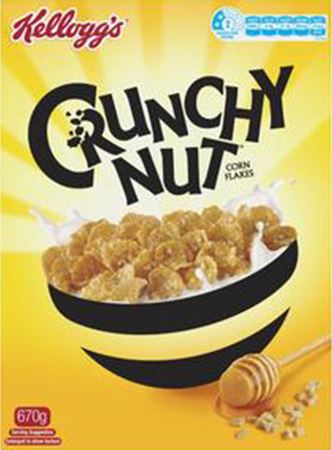
2. Kellogg’s Coco Pops
(36.5% sugar)
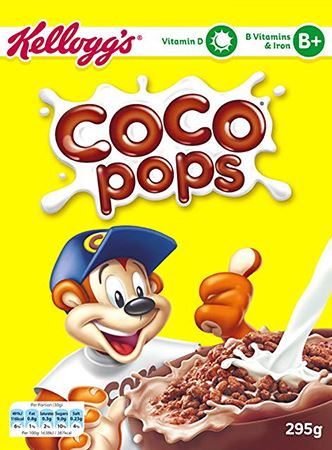
1. Kellogg’s Fruit Loops
(38% sugar)
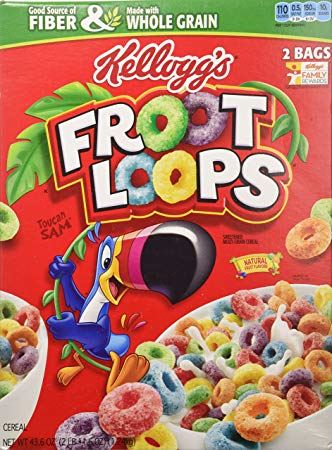
Other brands of unhealthy cereals you should avoid
UNHEALTHY MUESLI REVIEW
Morning Sun Natural 97% Fat Free Muesli 650g
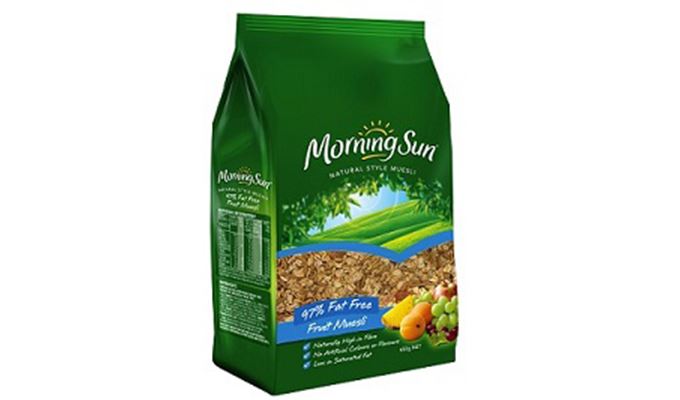
Muesli is generally a healthy choice, but sometimes a product proves this can be wrong! Don’t believe us? Let’s take a look at a not-so-healthy muesli sold in Australian supermarkets from Morning Sun.
Ingredients: Wholegrain Wheat (39%), Rolled Barley (36%), (Dried Fruits [Sultanas (8%), Currants (4%), Apricot (2%), Paw Paw Pieces (Paw Paw (0.7%), Sugar), Apple (1%), (Preservative ( 220 ), ( 223 )*)], Wheat Bran, Sugar, Malt Extract ( Barley ), Salt, Emulsifier (471). Vitamins and Minerals Vitamins(E, B1, Niacin, Folic Acid, B6, B2), Minerals (Iron and Zinc).
- Serving size: 45g
- Sugar per 100g: 14.1
- Fibre per 100g: 10.3
- Calories per 100g: 339
THE NUTRITIONIST’S VIEW: There are preservatives and emulsifiers in this cereal which we don’t recommend so sadly it doesn’t meet our ‘just eat real food’ philosophy. It also has added sugar which means it has a higher sugar content than we’d like. The fibre is high, so that is a positive, however this isn’t enough to overcome all the other negative factors, so we can’t consider it a “healthy cereal”. It’s better than Just Right, and it’s a lot better than something like Fruit Loops, but still, there are a lot of healthier alternatives out there so we’d recommend you give Morning Sun’s Natural 97% Fat Free Muesli a miss.
The cereal everyone always mistakes for being healthy…
Kellogg’s Just Right
Just not a healthy, everyday breakfast cereal choice.
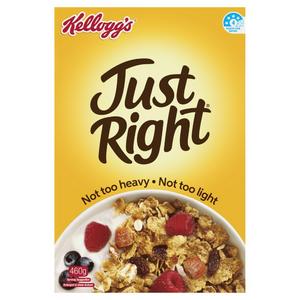
‘Just Right’ from Kelloggs is a perfect example of an unhealthy cereal that people regularly mistake for being good for you. If you take a look at the label, you’ll soon see why.
Ingredients: Whole Grains (64%)(Wheat, Oats), Fruit (Sultanas, Apricot Piece [5%] [Concentrated Apricot Puree, Concentrated Apple Puree, Invert Sugar, Humectant (Glycerol), Sugar, Wheat Fibre, Gelling Agent (Pectin), Acidity Regulator (296), Natural Flavour, Colours (Tumeric, Paprika)]), Sugar, Puffed Triticale, Wheat Flour, Barley Malt Extract, Salt, Natural Flavour, Minerals (Iron), Vitamins (Niacin, Riboflavin, Folate, Thiamin).
- Serving size: 40g
- Sugar per 100g: 22.9
- Fibre per 100g: 10.2
- Calories per 100g: 363 kcal
THE NUTRITIONIST’S VIEW: Looking at the above nutritional information, it’s clear there are numerous ingredients that do not meet our guidelines. Although there is a good level of fibre is high, this doesn’t outweigh the fact that Just Right cereal is made up of 23% sugar and is full of less than natural ingredients that should be avoided where possible, but certainly not consumed on a daily basis.
Quick health tip: Here’s how to make the healthiest cereal in Australia
As a nutritionist and a foodie, I can tell you that the healthiest and tastiest cereal in Australia is: Homemade muesli!
One of our favourite muesli time (and money) saving ‘hacks’ is to buy a large bag of rolled oats and a bag of mixed nuts from my local store and then… mixing them up in a container. Yes, it is that easy!
There isn’t a faster or healthier cereal we can think of!
The only time drain is that you’ll have to buy your ingredients, but after that, it only takes a few minutes to mix your ingredients in an airtight container and it’s good to serve. Then every morning, for the next month, you just have to pour and eat.

Save money by buying your rolled oats and mixed nuts in bulk.
Your healthy homemade muesli will store very well in the cupboard for up to a month, as long as you have a good quality airtight container.
Remember, eating healthy is often just about going back to basics, and keeping it simple.
In the end, healthy cereals, or food of any kind, comes down to choosing good quality ingredients. And if you only remember one thing today, remember what we always tell the 28ers on our program: just eat real food.
Want my help to eat healthier, get fitter and live your best life?
Our online nutrition & fitness program was designed to make healthy eating quick, easy and delicious. As a 28er you’ll not only have a tasty weekly food plan to follow, and quick and easy workouts you can do at home with me… but you’ll learn more healthy life hacks, just like you learned in this healthy cereal article!
Our program has helped over 400,000 people live healthier lives, and I’d love to help you too.




